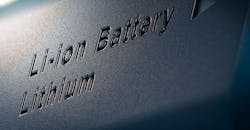When forming lithium-ion cells in manufacturing, or when testing large quantities of cells for evaluation, it’s important to select your charging and discharging systems with the proper size for the task. In manufacturing, where you may be charging and discharging thousands of cells at a time, total power consumption and heat generation must be considered. Oversizing a system to give margin may seem like a good idea, but you must take into account the additional capital cost, system size, and operational expenses.
Two key factors that need proper sizing are the maximum voltage of the charging circuit and the minimum voltage of the discharging circuit. Let’s look at each of these in more depth.
The cell itself will be the determining factor of the voltage that’s needed to charge the cell. For example, the maximum charging voltage may be 4.2 V. This voltage, of course, is the maximum voltage that must appear on the terminals of the cell, but this will not be the maximum voltage of the charging system.
The charger must be able to source more voltage to overcome voltage drop in the wires and the contacts to the cell. The available voltage at the terminals of the charger will need to be the sum of the maximum voltage on the cell (4.2 V in our example) plus the voltage drop in the wires, which will be the resistance of the wires times the maximum current flowing through the wires (Fig. 1).
1. Voltage drops in the wires when charging a cell.
Your first inclination may be to specify a charger voltage that is 2 or 3 V higher than the cell’s maximum charge voltage. This will give you a wide margin in the resistance that you can have in your wiring and contacts. By accommodating a high resistance wiring path, you can then use longer wires or thinner wires, simplifying fixture design.
However, while having extra voltage on the charger to accommodate a higher resistance path seems like a benefit, it comes at a high cost. First, consider the extra power needed by the charger. The power in the wires, which is V_drop × I_in_wire, must be added to the power being supplied by the charger. You will also need to buy a larger charger that can source more power to supply what was lost in the wires. You will pay for this power in increased electricity consumption.
Next, you must consider that the power in the wires will be lost as heat. Normally, the wires will be bundled together, and this heat can build up. Lastly, all of the excess heat generated by the more powerful charging circuit and the loss in the wires will add a larger heat burden on the environmental systems/air conditioning, which itself must be sized larger and will cost more (increased capital), as well as require more electricity to operate (increased operational expense).
Three Possible Scenarios
Let’s look at three cases:
Case 1: Charging a 3-AH 18650 cylindrical cell to 4.2 V, using 18 AWG wire of 20 feet total length (includes both positive and return path) and 20 mΩ of contact resistance
Case 2: Charging a 100-AH pouch cell to 4.2 V, using 4 AWG wire of 20 feet total length (includes both positive and return path) and 20 mΩ of contact resistance.
Case 3: Charging a 100-AH pouch cell to 4.2 V, using 0 AWG wire of 8 feet total length (includes both positive and return path) and 5 mΩ of contact resistance.
So, as you can see, simply deciding to give more voltage margin on wiring design to allow for an easier design with increased resistance of the wires has many ramifications on operational expenses and capital expenses. You must consider the tradeoffs.
What About Discharging?
Now, let’s look at discharging the cells. In this case, while the resistance of the wires still causes a voltage drop when discharge current flows, the voltage drop reduces the voltage on the cell when it gets to the terminals of the discharger circuit. This means the power of the discharger circuit can be lower, as some of the energy coming from the cell is lost in the wire before it gets to the discharger (Fig. 2).
2. Voltage drops in the wires when discharging a cell, too.
Generally speaking, discharger circuits are electronic loads. All electronic loads have a minimum operating voltage, typically on the order of 1 to 3 V. This means that you can pull full current into the discharger (load) until you hit the minimum operating voltage. Then, as the voltage at the terminals of the discharge decreases, the available current will be linearly derated (Fig. 3).
3. Shown is the operating voltage and current of a single channel of the Keysight BT2200 Cell Charger/Discharger System, used for forming cells in manufacturing. While the maximum charging voltage can go to 6 V, the drop in the wire needs to be considered. Note the minimum operating voltage during discharge and the derating from 1.9 V to 1.2 V.
So, if you're trying to discharge your cell down to 3.0 V, and if you have 2.5 V of drop in the wires (as in Case 2 above), the voltage at the discharger input is only 0.5 V. This is probably below the minimum voltage of the discharger; therefore, the available current will be derated as well.
You may not be able to pull enough discharge current to meet your testing requirements. It will cause you to have to specify a larger discharger in terms of maximum current, even though you won’t be using that maximum current. A larger discharger will drive up your equipment cost (capital expenses).
Like with charging, heat will exist in the wires, and they will be bundled together, causing the heat to build up.
Thus, once again, a simple decision to give more voltage margin on wiring design to allow for an easier design with increased resistance of the wires has many ramifications. You must consider the tradeoffs.
If your charging and discharging operation is on only a few cells at a time, perhaps the impact on operational costs and capital costs aren’t significant. However, when testing many cells or when forming cells in manufacturing, you will have many cells that need to be simultaneously tested. Each of those cells will require its own charger, discharger, fixture, and wiring. Wasted energy, excess heat, and increased equipment cost will be multiplied many times over.
About the Author
Bob Zollo
Solution Architect for Battery Testing, Electronic Industrial Solutions Group
Bob Zollo is solution architect for battery testing for energy and automotive solutions in the Electronic Industrial Solutions Group of Keysight Technologies. Bob has been with Keysight since 1984 and holds a degree in electrical engineering from Stevens Institute of Technology, Hoboken, N.J. He can be contacted at [email protected].






